Scottish Sea Fisheries Statistics 2012
A detailed overview of landings of sea fish; the Scottish fishing fleet; and the number of sea fishermen employed.
This document is part of a collection
1. Overview of landings
This chapter brings together information on the quantity, value, species and area of capture of sea fish landings. The focus is on Scottish based vessels and landings into Scotland.
1.1 Landings by Scottish based vessels
In 2012, Scottish based vessels landed 365 thousand tonnes of sea fish and shellfish into the UK and abroad with a value of £466 million ( Table 1.1.e and Chart 1.1.). This represents a two per cent increase in quantity but a nine per cent decrease in value in real terms compared to 2011, a record high year for landings value. However, the value of Scottish landings in 2012 remained higher than that landed in 2010.
Chart 1.1 Quantity and value of all landings by Scottish vessels: 2008 to 2012.

Landings by Scottish vessels accounted for 59 per cent of the value and 57 per cent of the quantity of all landings by UK vessels ( Tables 1.1.e, 1.1.o and 1.1.v). Since 2011, these figures have dropped one percentage point and three percentage points respectively.
1.1.1 Demersal, pelagic and shellfish landings by Scottish based vessels
In 2012, 200 thousand tonnes of pelagic species were landed by Scottish vessels with a value of £166 million. This accounted for 55 per cent of all landings by Scottish vessels in terms of quantity and 36 per cent in terms of value. Demersal species represented 26 per cent of the volume of all landings (96 thousand tonnes) and 31 per cent of the value (£143 million). Shellfish landings accounted for 19 per cent of landings by quantity (69 thousand tonnes) and 34 per cent by value (£157 million) (Chart 1.2).
Chart 1.2 Quantity and value of landings by Scottish vessels; percentage of each species type, 2012.
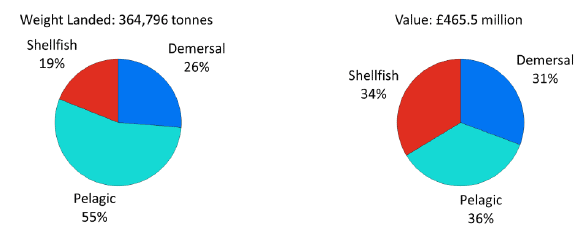
The nine per cent reduction in the value of landings by Scottish based vessels between 2011 and 2012 was driven by decreases in value across all species types (Chart 1.3). In real terms pelagic species saw a reduction in value of 11 per cent, demersal species value fell by eight per cent, whilst the value of shellfish landings decreased by six per cent from 2011. The main driver for the reduction in value across the different species types was the low prices obtained for key fish species (Chart 1.4). However, the vast majority of the total value lost from 2011 to 2012 is attributed to the loss in value of mackerel. Mackerel is the most valuable species to the Scottish fishing industry. It accounted for 28 per cent of the total value of Scottish landings in 2012 and 79 per cent of the value of pelagic landings. The value of mackerel in real terms fell 21 per cent from 2011, even though the quantity landed was only eight per cent lower. Mackerel value was further driven down by a 14 per cent decrease in price, from £1,134 per tonne to £976 per tonne. Mackerel's reduction in value contributed to half of the total loss in value of all landings by Scottish vessels between 2011 and 2012.
Chart 1.3 Quantity and value of landings by Scottish vessels by each species type; 2008 to 2012.

A breakdown of landings by Scottish vessels into Scotland, the rest of the UK, and abroad, by species are given in Tables 1.1.a to 1.1.e as well as corresponding figures for other UK vessels in Tables 1.1.f to 1.1.o, and figures for foreign vessels landings into the UK in Tables 1.1.p to 1.1.t.
Chart 1.4 Percentage change from 2011 to 2012 in the real term price obtained for key fish species.
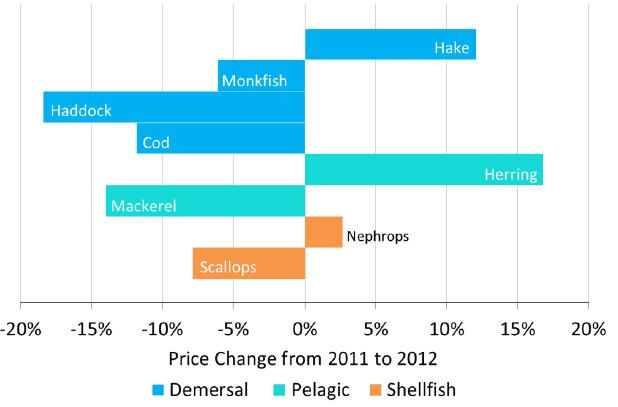
Prices of fish in 2012 and other years can be found in Table 1.1.x.
Demersal fish
Demersal species contributed 31 per cent of the overall value of landings by Scottish vessels in 2012. Haddock, monkfish and cod are the three main demersal fish landed by Scottish vessels in terms of value, accounting for 22 per cent, 19 per cent and 15 per cent respectively of all the demersal species landed in 2012.
The value of demersal species decreased eight per cent from 2011, driven by reductions in value of various species including monkfish and cod, which fell 20 per cent to £27.3 million, and eight per cent to £21.4 million, respectively (Chart 1.5.a). The value of monkfish fell due to a combination of a 14 per cent decrease in the quantity landed, and a six per cent decrease in price. Cod's decrease in value was driven by the 12 per cent decrease in price as the quantity landed increased by four per cent. The effect of the reductions in value of monkfish, cod and other demersal species on the overall demersal sector value, was buffered by the increase in value of hake and haddock. Hake accounted for ten per cent of the total demersal value. From 2011 the value of hake rose by 18 per cent due to an increase in price of 12 per cent and a five per cent increase in the volume landed. Haddock was the other demersal species to see a rise in value, amounting to two per cent. This slight increase in the value of haddock occurred despite a large fall in price of 18 per cent compared to 2011(Chart 1.4). The increase in value resulted from a 25 per cent increase in the quantity of haddock landed in 2012 from 2011, mainly due to an increase of quota for haddock.
Chart 1.5.a Quantity and value of landings of the key demersal species by Scottish vessels: 2008 to 2012.
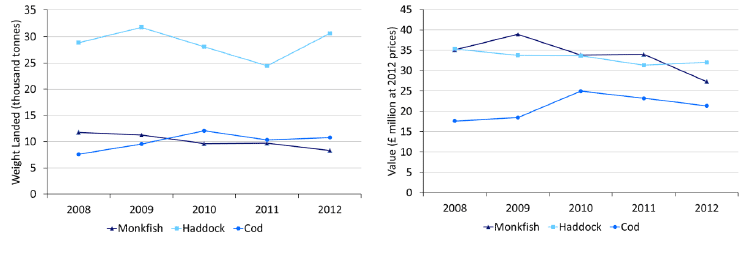
Pelagic fish
Mackerel and herring are the two main pelagic fish landed by Scottish vessels in terms of both quantity and value. Mackerel, the most valuable stock to the Scottish sea fishing industry, accounted for 79 per cent of the value and 67 per cent of the quantity of all the pelagic landings by Scottish vessels in 2012. Herring accounted for 17 per cent of the value and 27 per cent of the quantity. In comparison to 2011, the contribution of mackerel landings (£131.1 million) to total pelagic value reduced by ten percentage points, whilst herring's contribution (£29 million) to the total pelagic value increased by eight percentage points.
From 2011 to 2012, the value of mackerel decreased by 21 per cent, whilst herring increased substantially by 68 per cent (Chart 1.5.b). These changes in value were largely due to changes in price and the quantity landed. Whilst the volume of mackerel landed reduced by eight per cent, the price suffered a 14 per cent decrease, driving the value of mackerel down. In contrast, herring's large increase in value was due to a 44 per cent increase in the volume of herring landed by Scottish based vessels in 2012 and a 17 per cent increase in price (Chart 1.4). This large increase in the quantity landed was a result of a large increase in quota ( Tables 1.10).
Chart 1.5.b Quantity and value of landings of the key pelagic species by Scottish vessels: 2008 to 2012.
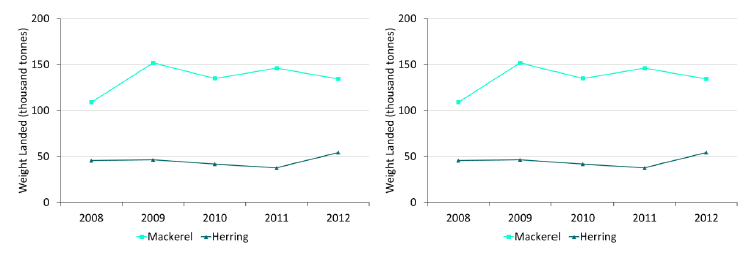
Shellfish
Nephrops and scallops are the two main species of shellfish landed by Scottish vessels. Nephrops accounted for 53 per cent of the value and 31 per cent of the quantity of shellfish landed by Scottish vessels in 2012. Scallop landings accounted for 20 per cent of the value and 25 per cent of the quantity of all shellfish landings by Scottish vessels in 2012.
Nephrops are the most valuable shellfish species to the Scottish fishing industry, worth £82.4 million in 2012 and accounting for 18 per cent of the total value of all Scottish landings. The value of Nephrops landings by Scottish vessels decreased four per cent in real terms from 2011. This decrease in value was driven by a six per cent decrease in the quantity landed (21 thousand tonnes) but was buffered slightly by a three per cent rise in the price of Nephrops. The value of scallop landings in 2012 remained similar to that in 2011, despite an eight per cent decrease in price (Chart 1.4). This is a result of an eight per cent increase in volume of landings. This increase in scallop landings represents 1.3 thousand tonnes, offsetting the decrease in quantity landed of the other key shellfish species.
Squid, lobsters and Queen scallops all reduced considerably in terms of value and weight landed between 2011 and 2012. Edible crab value and weight landed remained fairly constant, dropping only three per cent. Squid landings experienced the greatest changes from 2011 and 2012; decreases of 31 per cent in terms of volume landed and 20 per cent in terms of price. This combination resulted in squid dropping 45 per cent of its value, from £9.3 million to £5.1 million. However, the 2012 value of squid is similar to the 2008 and 2009 real term values, suggesting that 2010 and 2011 could have been good years for squid.
Chart 1.5.c Quantity and value of landings of the key shellfish species by Scottish vessels: 2008 to 2012.
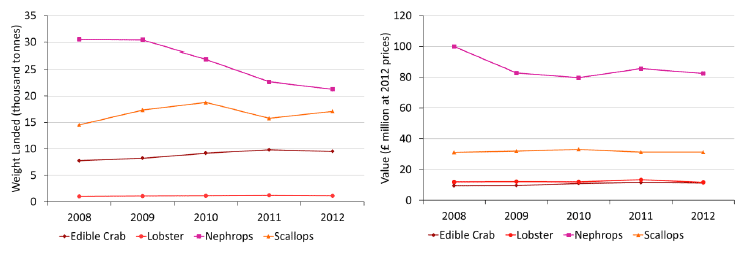
1.2 Landings abroad by Scottish based vessels
In 2012, Scottish vessels landed 113 thousand tonnes of fish abroad with a value of £112 million. Despite an overall increase of only two per cent in the quantity of fish landed by Scottish vessels everywhere, the volume of landings abroad increased by ten per cent and the value of landings abroad increased by 14 per cent in real terms since 2011.
Landings abroad accounted for 31 per cent of all landings by Scottish vessels in terms of volume and 24 per cent in terms of value. Of this, 86 per cent of the quantity of landings abroad was pelagic; 12 per cent were demersal and two per cent were shellfish. The main species landed abroad was mackerel, contributing £72.9 million, 65 per cent of the total value of fish landed abroad. Mackerel landings abroad have increased in volume by 18 per cent and increased in value (real terms) by nine per cent since 2011. This occurred despite an overall decrease of eight per cent in terms of quantity across all mackerel landings. More mackerel caught by Scottish vessels in 2012 was landed abroad than into the whole of the UK. This could be partly attributed to the difference in price obtained between domestic and foreign landings. The price for mackerel landed into the UK in 2012 was, on average, £939 per tonne, but for mackerel landed abroad fisherman received an average of £1,008 per tonne. This could be an influencing factor for decisions on where to land.
The majority of Scottish landings abroad are into Norway, and nearly all of these landings are pelagic species. In 2012, 84 per cent of the value of landings into Norway was for mackerel; 67.5 thousand tonnes with value of £68.8 million. In 2012, Scottish vessels landed 13.2 thousand tonnes of demersal species abroad with a value of £20 million. The key countries for demersal landings are Ireland, Spain, Denmark and the Netherlands. Only 2.7 thousand tonnes of shellfish was landed abroad by Scottish vessels in 2012, mainly into Spain and France.
Figure 1.1.a Quantity of landings abroad by Scottish vessels by country of landing: 2012 (tonnes).
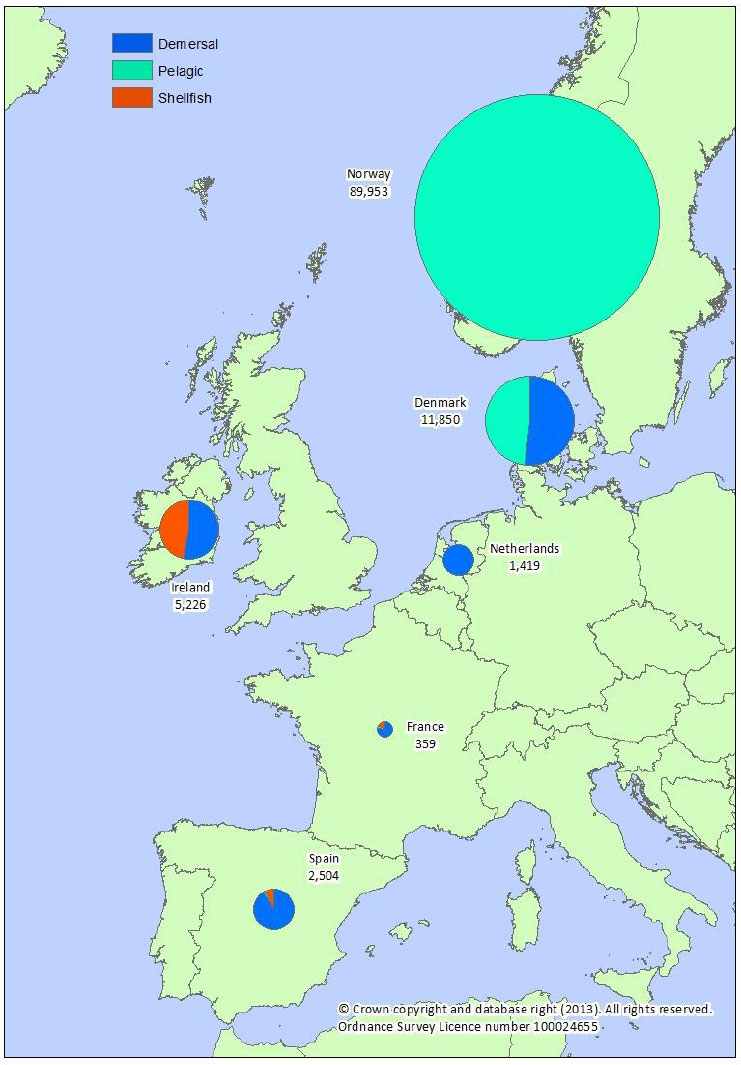
Figure 1.1.b Value of landings abroad by Scottish vessels by country of landing: 2012 (£' thousands).
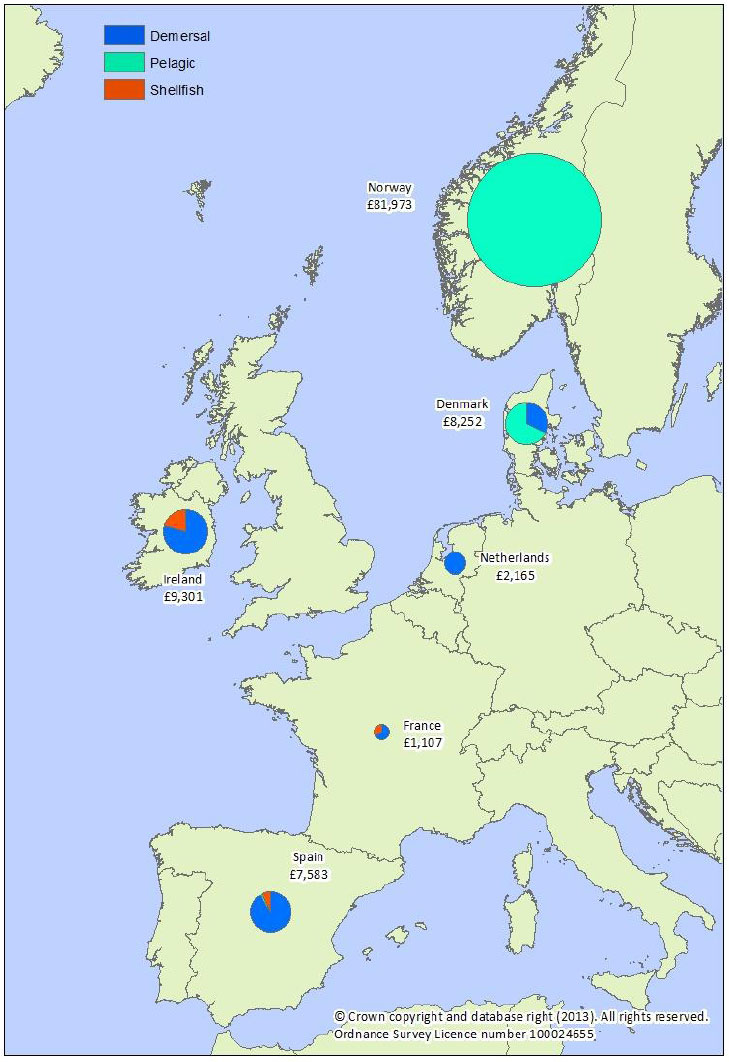
1.3 Landings by area of capture
The two main ICES areas that Scottish vessels were most active in during 2012 were the Northern North Sea ( ICES division IVa) and the West Coast of Scotland ( ICES division VIa) (Figures 1.2.a and 1.2.b). In the Northern North Sea, 161 thousand tonnes of fish were caught with a value of £190 million, representing 41 per cent of the value of all landings by Scottish vessels. Over a third of landings by Scottish vessels, in terms of quantity, were caught in the West Coast of Scotland, providing 37 per cent of the total value of all Scottish landings.
Sixty one per cent of the volume of all demersal landings by Scottish vessels, and 45 per cent of pelagic landings, were caught in the Northern North Sea. In the West Coast of Scotland a similar quantity of pelagic species (83 thousand tonnes) were caught, but more shellfish species were caught in the West Coast than in the Northern North Sea. Shellfish catch from the West of Scotland accounted for 42 per cent of all shellfish catches, in terms of quantity. The Central North Sea ( ICES division IVb) and the Irish Sea (VIIa) are also areas of considerable activity for shellfish fisheries. Eighteen per cent of shellfish catches are from the Irish Sea whilst 11 per cent are from the Central North Sea. Almost all catches from the Irish Sea are of shellfish species, with a total value of £9.4 million. Seven per cent of all catches were caught in the rest of Area VII (i.e. not the Irish Sea). This area has reasonable activity from demersal, pelagic and shellfish vessels.
Further maps of fishing activity in the seas around the UK by Scottish vessels, other UK vessels, and foreign vessels that land into the UK will be available on the ICES rectangle webpage on the Scottish Sea Fisheries Statistics website. These maps show the quantity and value of landings by species type by ICES rectangle.
Figure 1.2.a Quantity of landings by Scottish vessels by area of capture: 2012 (tonnes).
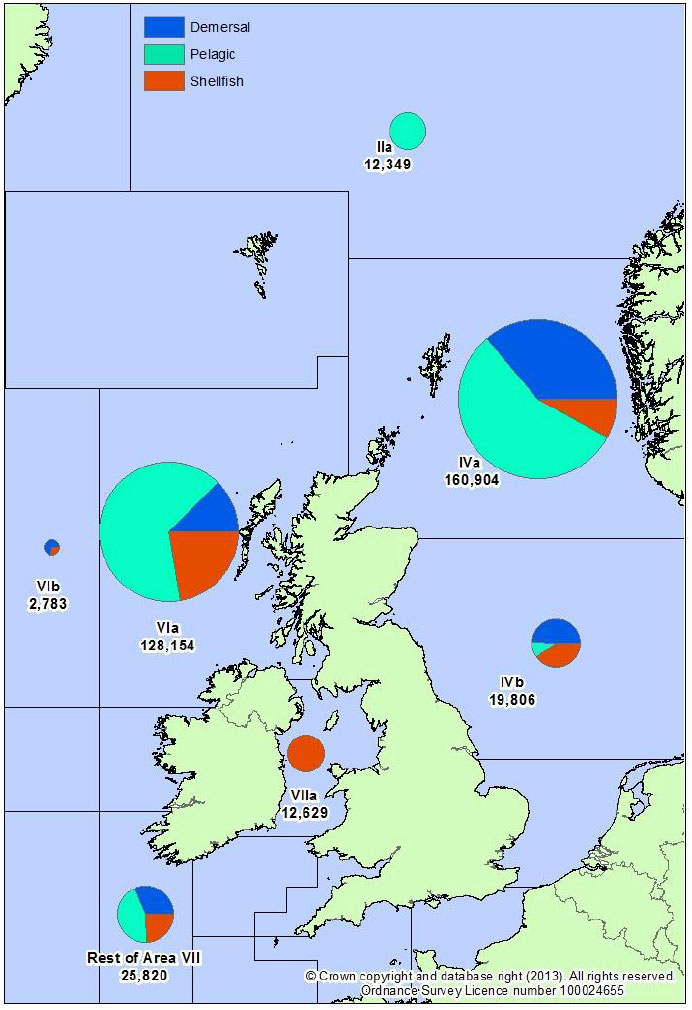
Figure 1.2.b Value of landings by Scottish vessels by area of capture: 2012 (£'thousand).
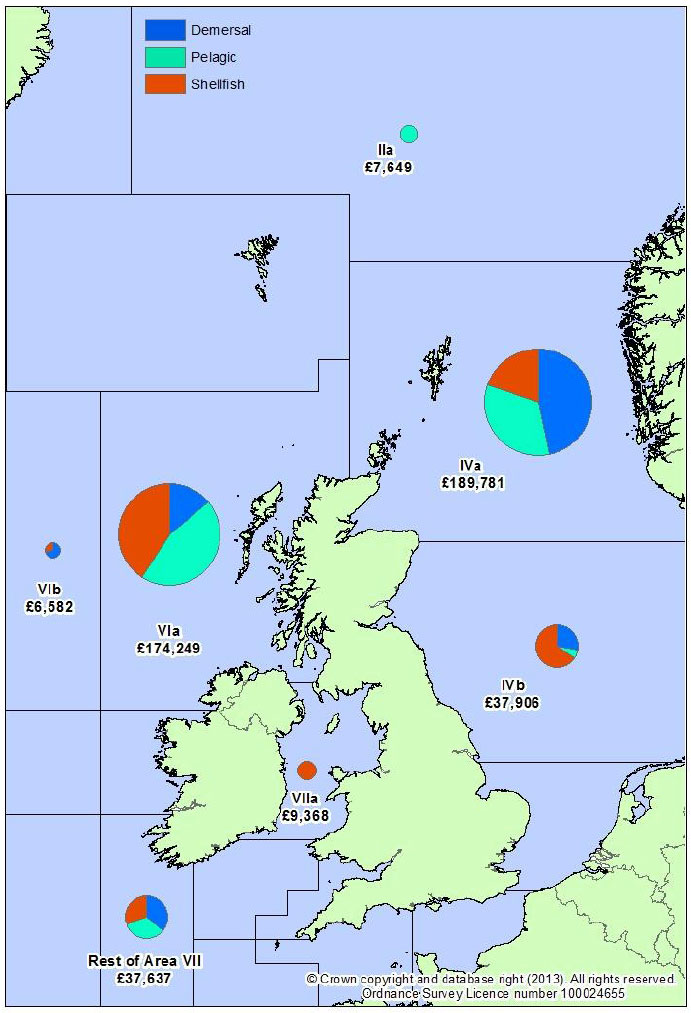
1.4 Landings into Scotland
In 2012, there were 331 thousand tonnes of sea fish and shellfish landed into Scotland with a value of £419 million. This is an increase of five per cent in terms of volume and a decrease of 14 per cent in terms of value from 2011. Landings of demersal, pelagic and shellfish species all contributed similarly in terms of value to the total value of all landings into Scotland. However, in terms of volume, 51 per cent of landings into Scotland were pelagic, 31 per cent were demersal and 17 per cent were shellfish species. The differences in how each species type contributed to the total value and total volume of landings into Scotland highlights the differences between the prices per tonne across the species types. Shellfish receive relatively high prices per tonne, whilst pelagic species receive lower prices per tonne ( Table 1.1).
Figure 1.3.a and b show landings by all vessels by species type into the eighteen Scottish districts. Landings into the south-west coast and south-east coast were dominated by shellfish, while landings into the north-west coast constituted both demersal and, to a lesser extent, shellfish species. The three largest districts in Scotland in terms of landings were; Peterhead (east coast), Shetland (north) and Fraserburgh (east coast). These districts receive landings of all three species types, but Peterhead and Shetland receive relatively small amounts of shellfish compared to demersal and pelagic species.
Combined, the top three districts accounted for 74 per cent in quantity and 57 per cent in value of all landings into Scotland. One hundred and fifty two thousand tonnes, worth £142 million, were landed into Peterhead. In terms of volume, two thirds (67 per cent) of the landings were pelagic accounting for 49 per cent of landings value into Peterhead. Landings into Shetland totalled 67 thousand tonnes at a value of £59 million, just over a third less than in 2011. This reduction in value was driven by a 46 per cent decrease in the value of pelagic species landed into Shetland. Pelagic species accounted for 57 per cent of the total value landed into Shetland, whilst demersal species accounted for 36 per cent and shellfish species accounted for seven per cent. In contrast, the third biggest district, Fraserburgh, was dominated by shellfish landings, representing over half the value of the landings. In terms of volume, over half of landings into Fraserburgh were pelagic species and 23 per cent were shellfish landings.
Figure 1.3.a Quantity of landings into Scotland by all vessels by district: 2012 (tonnes).
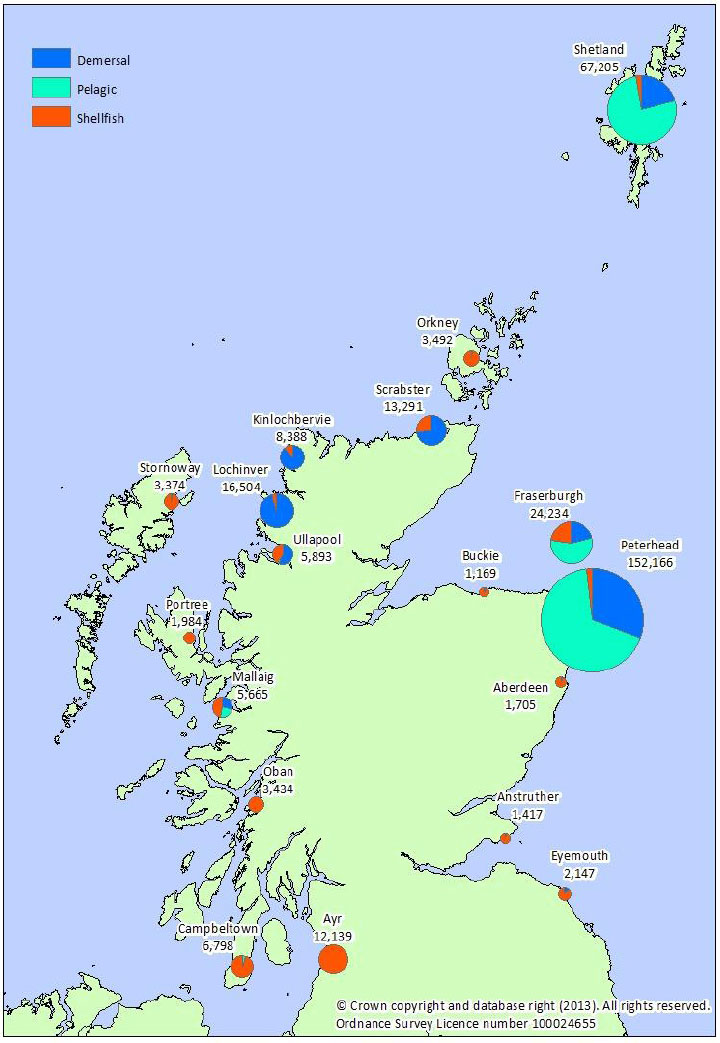
Figure 1.3.b Value of landings into Scotland by Scottish vessels by district: 2012 (£'thousand).
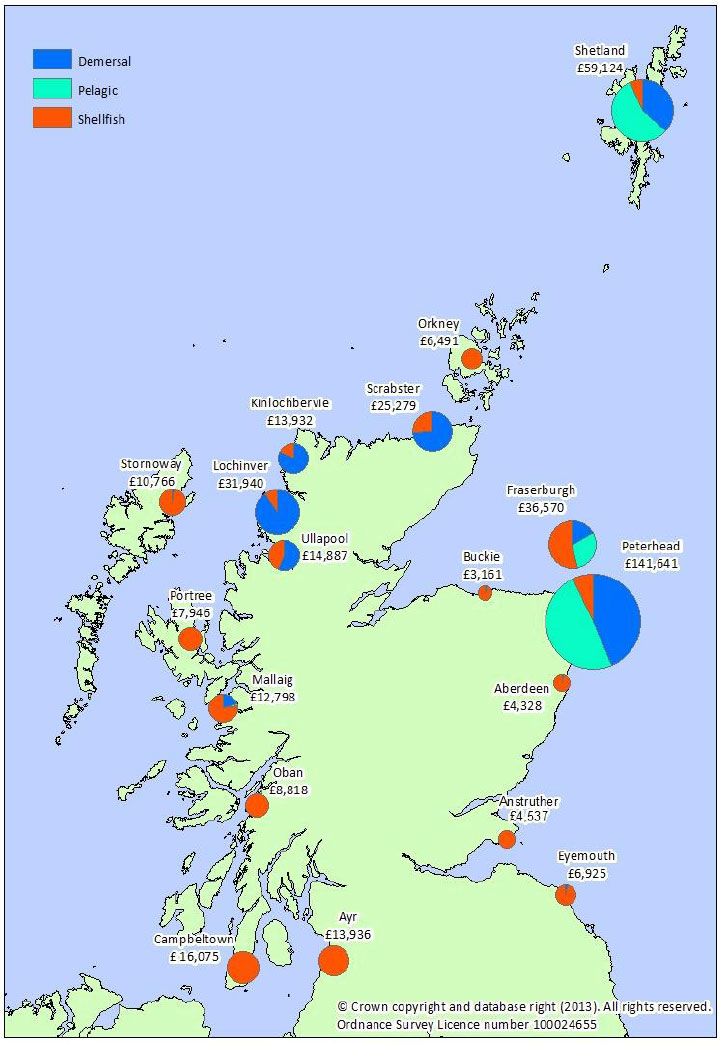
1.5 Total allowable catches quota and uptake
Table 1.10 shows the total allowable catch ( TAC) for stocks. TACs are a catch limit set by the European Commission for individual stocks. TACs are fixed on an annual basis at negotiations held by EU member states. A share of the EU TAC is allocated to EU member states based on a number of factors, including the member state's past catch record. This share, known as quota, is displayed in Table 1.10 at the UK and at the Scottish Producers Organisations ( POs) level. The quantity and percentage uptake of this quota is also given for each stock in Table 1.10.
Chart 1.5 compares the quota uptake of important demersal and pelagic stocks in Scottish Producer Organisations in 2012 and 2011. North Sea cod, haddock, whiting and saithe all exceeded 90 per cent quota uptake in 2012. North Sea Nephrops and monkfish quota uptake was relatively low, at 54 per cent and 62 per cent, respectively. At the end of 2012, North Sea Nephrops uptake was 14 percentage points below what it was in 2011. This is an outcome of the continuation of poor Nephrops availability in the Fladens. North Sea monkfish quota uptake was 26 percentage points lower than in 2011 which was partly due to a slight increase in quota. The West of Scotland demersal stocks had generally lower quota uptakes than North Sea stocks, which is not out of the ordinary. Quota uptake for the important pelagic stocks all reached or exceeded 100 per cent.
Chart 1.6 Quota uptakes of important stocks by vessels in Scottish POs in 2012 and 2011.
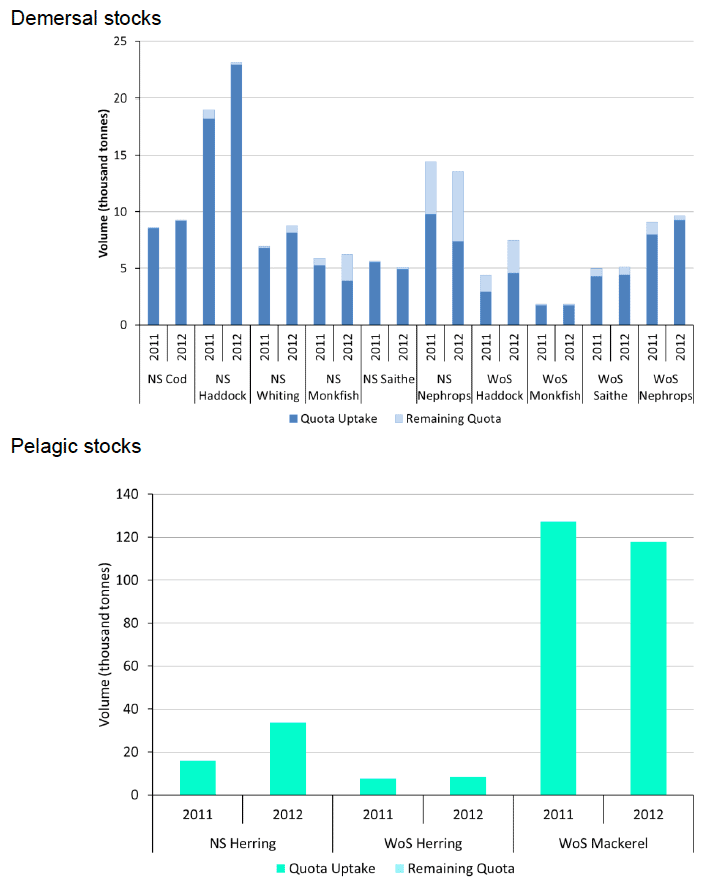
Contact
There is a problem
Thanks for your feedback